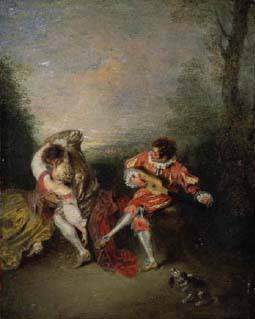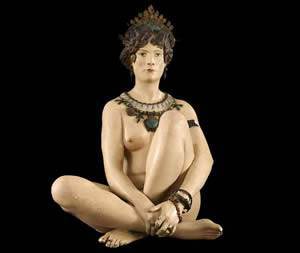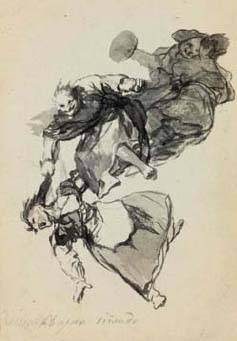
Jean-Antoine Watteau (Valenciennes 1684-1721)
La Surprise
Extimate: £3,000,000-5,000,000
Watteau’s La Surprise for sale at Christie’s Christie’s announce the rediscovery of La Surprise by Jean-Antoine Watteau (1684-1721). The painting has been missing for almost 200 years, presumed to have been destroyed, and was previously known only by a copy in the Royal Collection at Buckingham Palace and through a contemporary engraving]]>
July 1st 2008, source: Christie’s
Christie’s announce the rediscovery of La Surprise by Jean-Antoine Watteau (1684-1721). The painting has been missing for almost 200 years, presumed to have been destroyed, and was previously known only by a copy in the Royal Collection at Buckingham Palace and through a contemporary engraving. It was found in the corner of a drawing room in a British country house during a valuation last year and will be offered at Christie’s auction of Important Old Master and British Pictures on 8 July 2008 where it is expected to realise £3 million to £5 million and establish a world record price for the artist.
Richard Knight, International Director of Christie’s Old Master Department and Paul Raison, Director and Head of Old Master Pictures at Christie’s, London: “We are extremely excited to have rediscovered Watteau’s ‘La Surprise’, whose whereabouts have been a mystery for almost 200 years. This is not only one of the most extraordinary rediscoveries of recent years, but also presents the opportunity to buy one of the greatest paintings by the artist to have been seen on the market for decades. The impressive provenance and untouched condition of this picture make it all the more exciting. We very much look forward to exhibiting this remarkable rediscovery to the public for the first time in almost two centuries in New York from 10 to 14 April and at our King Street salerooms in London from 5 to 8 July, and we expect to welcome interest from private collectors and institutions from around the world when this remarkable painting is offered at auction on 8 July in London.”
La Surprise by Jean-Antoine Watteau (1684-1721) was painted circa 1718 and was first owned by Nicolas Henin (1691-1724), an Advisor to the French King who was one of Watteau’s best and most constant friends. It is likely that the work was painted for Henin together with its pendant L’Accord Parfait, now in the Los Angeles Museum of Art. The legendary connoisseur and collector Pierre-Jean Mariette(1694-1774) noted in his Abecedario of 1746 that La Surprise is “one of [Watteau’s] most beautiful paintings”. On Nicolas Henin’s death in 1724, the two paintings went to the artist’s friend and biographer Jean de Jullienne (1686–1766) who had them engraved and published in the Recueil Jullienne, and who seems to have split the pair and sold them before 1756. La Surprise next appears in the celebrated collection of Ange-Laurent de La Live de Jully (1725-1779), who is recognised as assembling the first serious art collection dedicated to the encyclopedic display of French painting. The catalogue of his collection was published in 1764 and describes La Surprise as executed “with a piquant touch and richly tinted with the color of Rubens”. The picture had left the collection by 1770 and amidst the turmoil of the French Revolution, it is not recorded until it appears in a Lady Murray’s probate valuation of 1848, by whom it was bequeathed to the family of the present owners. The painting’s attribution and significance have remained lost until its rediscovery last year.
Watteau had a highly unusual, improvisational method of composing his paintings. Having selected several appropriate figure studies from his many bound books of drawings, he then reproduced them in oil paint on canvases where he had already executed a landscape background. He adjusted the figural groups to harmonize with the landscape setting, and frequently altered or even painted out complete figures as he perfected his final composition. He rarely seems to have followed a compositional plan and La Surprise is no exception; radiographs of the underpaint reveal an entirely different composition beneath the present one which the artist subsequently painted over. In a parkland paradise, as the sun begins to set, an actor from the Comedie Italienne, dressed as the character Mezzetin, sits on a stone bench, knees crossed, playing his guitar. He looks to his right at an amorous couple, also seated on the bench, who kiss each other in a passionate embrace. The figures of the amorous couple are copied from a pair of dancing figures in Rubens’s famous painting The Kermesse of circa 1635, today in the Louvre and at the time, one of the treasures of the French royal collection. A pet dog watches his human companions with avid curiosity; the dog also has its origins in the work of the Flemish artist, this time from Rubens’s vast cycle devoted to the Life of Marie de’Medicis (Louvre, Paris) then installed in a public gallery of the Luxembourg Palace.
Jean-Antoine Watteau (1684-1721) was born in the Flemish town of Valenciennes, which had passed to France from Spanish rule just 6 years earlier, and left for Paris in about 1702. He was to be influenced by Flemish art throughout his career, and was often considered a Flemish painter by his contemporaries. In Paris, he worked with Claude Gillot (1673-1722) and became fascinated by theatre costume and stage design, before moving to the workshop of Claude Audran III, curator of the Palais du Luxembourg where Watteau was introduced to Rubens’ magnificent and inspirational canvases painted for Queen Marie de Medici. The work of Rubens was to influence Watteau throughout his career as he revitalised the Baroque style and became a pioneer of Rococo art. Watteau was frail and subject to ill health throughout his life and in 1720, he travelled to London to visit Dr. Richard Mead, a celebrated physician, in the hope of medical relief. Unfortunately, the climate and air quality in the city hindered any progress and he returned to France where he died in 1721 at the age of 37.
Follow us on:


